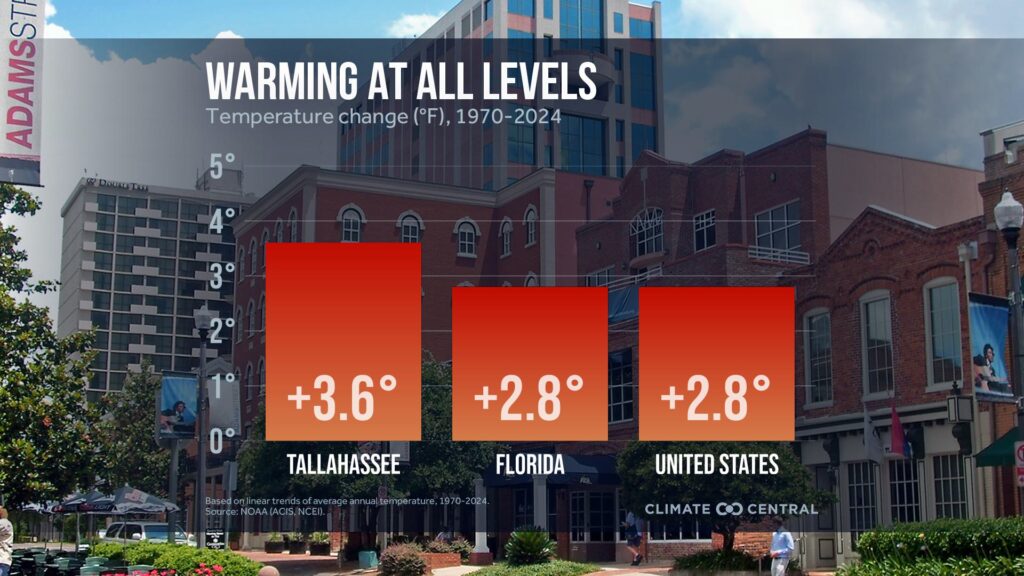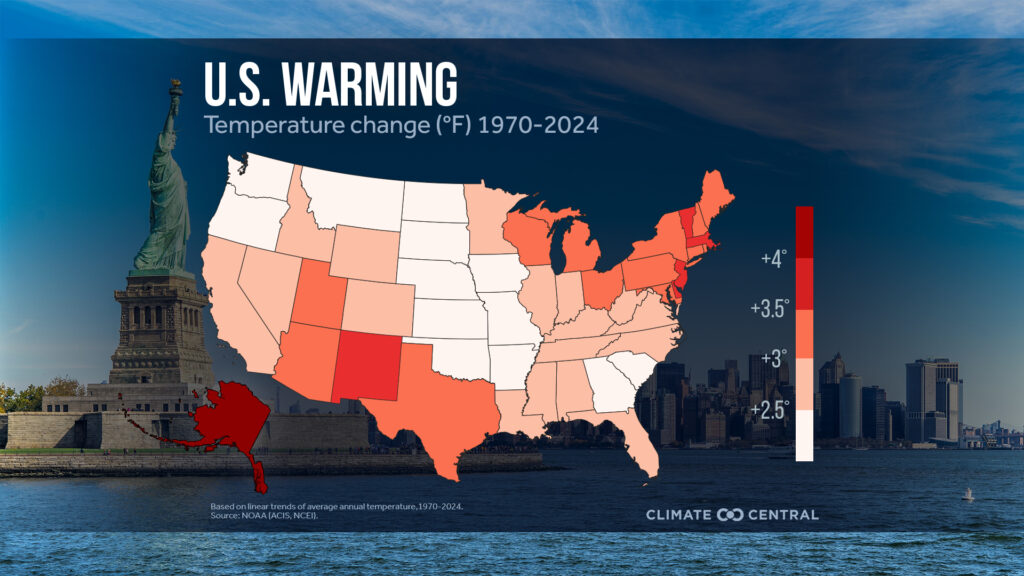By Morgann Rhule, The Invading Sea
Since the first Earth Day in 1970, nearly every U.S. city and state has warmed significantly, according to a new study from Climate Central.
The national average temperature has increased by 2.8 F, and Florida matches that figure, the study found. However, some cities in the Sunshine State are feeling the heat more than others.

Tampa leads the state’s warming trend with an average increase of 3.8 F, followed by Tallahassee (3.6 F), Sarasota (3.2 F) and Miami (3.1 F). Orlando (2.0 F), Jacksonville (2.0 F) and Pensacola (2.6 F) fall closer to the national average, while Gainesville stands out with a much lower warming trend of just 0.5 F.
Daniel Gilford, a climate scientist at Climate Central, said greenhouse gas emissions are leading to an increase in temperature across the planet.
“Human beings have been consistently putting carbon dioxide and other heat-trapping gases, such as methane and nitrous oxide, into the atmosphere at quite alarming rates,” Gilford said.
The report analyzed average annual temperature trends in 49 states and 242 U.S. cities. Every state and 240 of the cities have warmed from 1970-2024, Climate Central found.
Nationally, 203 cities (84%) have warmed at least 2 F, with western and northeastern cities topping the list. Reno, Las Vegas and El Paso showed the highest jumps.
The rise in temperature has implications for everything from health to energy bills, Gilford said.
“When the environment outside is much warmer, that’s quite bad for us,” he said. :It can be bad for our health, it can be bad for the ecosystems where we like to spend time, and it can be bad for our air-conditioning bill.”
While Florida may not be the fastest-warming state, Gilford emphasizes that the impacts are still significant, especially given the state’s geography and population density along the coast.

With much of the state’s population living near the ocean, the combination of rising seas, extreme weather and heat present more troubles.
“Miami is in a very vulnerable condition,” Gilford explained. “We love our water here in Florida — it’s a huge part of the appeal. But part of the problem with being on the coast is we’re more exposed to the risks, for example hurricanes, sea level rise and extreme heat.”
The variation in warming rates across Florida cities is caused by local conditions, such as proximity to water or influence from cold fronts, influence how fast a place warms.
“It depends entirely on the particular city,” Gilford said. “Certain places that are closer to the coastline may be experiencing increased warming. Others may be influenced by colder weather systems.”
Without a dramatic reduction in heat-trapping pollution, he said, the warming trend is likely to continue.
“As long as we continue to burn fossil fuels, those increases should be expected to continue,” Gilford said. “And that will continue to put Floridians, and people all across the country, at risk.”
Morgann Rhule is a senior majoring in multimedia journalism at Florida Atlantic University who is reporting for The Invading Sea during the spring 2025 semester. Banner photo: A sunset over dunes in Florida (Charles Patrick Ewing, CC BY 2.0, via Wikimedia Commons).
Sign up for The Invading Sea newsletter by visiting here. To support The Invading Sea, click here to make a donation. If you are interested in submitting an opinion piece to The Invading Sea, email Editor Nathan Crabbe at ncrabbe@fau.edu. To learn more about greenhouse gas emissions, watch the video below.



